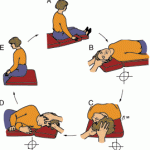Benign Paroxysmal Positional Vertigo (BPPV) is a non-life-threatening condition of the vestibular system, the organ of balance and equilibrium.
BPPV is characterised by dizziness, vertigo, loss of balance and sometimes nausea. These effects often appear unexpected and for no obvious reason. They are bought on by innocuous, everyday movements of the head.
Fortunately, the mechanism that causes these symptoms is well understood, and the solution is simple.
To understand what is happening in BPPV, we have to look at anatomy. 
The vestibular system, the organ of balance and equilibrium, sits in the middle ear alongside the structures of hearing.
It consists of three main components: Utricle, Saccule, and Semicircular Canals. (The latter have expanded the termini to include Ampullae.)
Within the Utricle, Saccule, and Ampullae are cells called hair cells with tiny hairs attached.
In the Uterus and Saccule, these cells sit in a jellylike substance whose surface is covered in small calcium structures called Otoliths.
Each hair cell is innervated by nerve fibres, branches of the vestibular nerve, which relay information about balance and equilibrium to the brain. The Utricle, Saccule, Semi-circular canals and Ampullae are all full of fluid.
When the head moves, so does the fluid. This fluid movement bends the hairs on the hair cells, relaying a nerve impulse to the brain.
In normal circumstances, this sequence of events is only initiated by the movement of the head.
In the case of BPPV, a stray Otolith causes it. A dislodged Otolith can make its way out of the Utricle or Saccule and into one of the Semi-Circular Canals. Here, it increases the fluid’s momentum, causing feelings of dizziness, vertigo, and loss of balance.
Fortunately, this is not a serious condition, and the solution is fairly straightforward. 
It involves moving the head through a set of prescribed movements to encourage the Otolith back into the utricle or saccule.
The movements are gentle, measured, and safe. They may bring on dizziness, but this is part of the process.
They vary depending on which semi-circular canal the Otolith is sitting in.
The Epley Manoeuvres return the Otolith from the Posterior Semicircular Canal. They are the most well-known and effective treatment for the most common form of BPPV, Posterior Canal BPPV. Others include the Gufoni and Deep Head Hanging manoeuvres.
For treating BPPV, we recommend that you consult a highly skilled and experienced physical therapist with a refined understanding of anatomy and physiology.
April 16th 2025
span style font-weight Are you struggling to get back into the gym feeling unmotivated post-lockdown or simply not seeing results from your hard work span nbsp span style font-weight A personal trainer PT could help span span style font-weight A personal trainer can be a great resource from tailored training...
READ MOREApril 16th 2025
h What is Benign Paroxysmal Positional Vertigo or BPPV for short h nbsp Benign Paroxysmal Positional Vertigo BPPV is a non-life-threatening condition of the vestibular system the organ of balance and equilibrium nbsp h What are the symptoms of BPPV h nbsp BPPV is characterised by dizziness vertigo loss of...
READ MOREApril 16th 2025
span style font-weight While pushing to improve your technique and achieving results are both important parts of workout regimes another essential element yet one which is all too often overlooked is recovery or prehabilitation span nbsp strong What do we mean by the term prehabilitation strong nbsp span style font-weight...
READ MORE